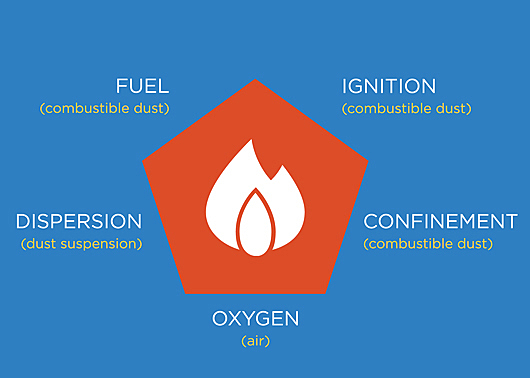
It’s finally here, the panacea of combustible dust control. We’re talking about NFPA 652: Standard on the Fundamentals of Combustible Dust.
The new standard sets out to be the single, go-to source for handling combustible dusts, no matter what industry you’re in, or where you live in the world.
The National Fire Protection Agency (NFPA) announced the standard’s release at the American Industrial Hygiene conference and exposition (AIHce) on May 25, 2016 after its approval on September 7, 2015.
The NFPA published the new standard as an answer to a lack of understanding of what combustible dust hazards are, and to smooth out some inconsistent guidelines in their existing commodity-specific standards.
The new standards apply to all logistics and facilities involved with handling or producing combustible dusts and combustible particulate solids. They give straightforward guidelines on when to use commodity-specific standards, and when to use the shared standards.
Here’s a breakdown of what the standard includes, and how it will work for your industry.
The three fundamental principles
NFPA 652 promotes awareness of the three following fundamental principles:
- Controlling the fuel
- Controlling the ignition sources
- Limiting the spread of any combustion event
This means ensuring that you are reducing the number of factors from the dust explosion pentagon, and installing the proper equipment to reduce the effects of an explosion, if one should happen.
Techniques for your Dust Hazard Analysis
Under NFPA 652, a Dust Hazard Analysis (DHA) is mandatory for all new and existing facilities that handle, generate, store or process combustible dusts.
The DHA determines what the risks are of a potential fire or explosion based on the type of combustible dust or particulate solid in the facility and its processes. It also defines ways to prevent or mitigate dust hazards and accidents, and gives recommendations for training those involved about their workplace hazards.
For existing facilities, the DHA is required within three years of the standard’s release in September 2015.
The DHA is not the same as a Process Hazard Analysis (PHA) needed for refineries or chemical manufacturing. The PHA is a more rigorous analysis and it isn’t necessary for all industries.
There are several testing methods that you can apply for your DHA:
- Hazard Operability Analysis (HAZOP)
- Checklist Analysis
- Failure Mode Effects Analysis (FMEA)
- Layers of Protection Analysis
- United Nations: Transport of Dangerous Goods Manual of Tests & Criteria—Test method for Readily Combustible Solids
- ASTEM E1226: Standard Test Method for Explosibility of Dust Clouds
- ASTM E1515: Standard Test method for Minimum Explosible Concentration of Combustible Dusts
What commodity specific codes are covered?
The standard overlaps with some of the existing commodity specific standards:
- NFPA 61: Standard for the Prevention of Fires and Dust Explosions in Agricultural and Food Processing Facilities
- NFPA 484: Standard for Combustible Metals
- NFPA 654: Standard for the Prevention of Fire and Dust Explosions from the Manufacturing, Processing, and Handling of Combustible Particulate Solids
- NFPA 655: Standard for Prevention of Sulfur Fires and Explosions
- NFPA 664: Standard for the Prevention of Fires and Explosions in Wood Processing and Woodworking Facilities
New 2017 editions of NFPA 61, 652 and 664 standards have already been issued electronically, and the remaining commodity specific standards are set to be updated in following years. NFPA 652 also points to explosion prevention standards NFPA 67: Guide on Explosion Protection for Gaseous Mixtures in Pipe Systems, NFPA 68: Standard on Explosion Protection by Deflagration Venting and NFPA 69: Standard on Explosion Prevention Systems.
When commodity specific NFPA standards prohibit a new requirement set out in NFPA 652, you should follow the pre-existing prohibitive rule in the commodity-specific standard.
How can I make my plant NFPA 652 compliant?
There are two compliance options outlined in NFPA 652:
- Prescriptive Compliance where facilities follow pre-existing steps to take to meet their goal of complying with NFPA 652.
- Performance-Based Compliance where facilities begin with the goal of complying with NFPA 652 and adjust their method throughout the adjustment process.
Redesigning entire facilities is not mandatory under NFPA 652, but it is a requirement to conduct employee training and perform proper housekeeping duties.
You might also be interested in:
For more information on combustible dust, NFPA compliance, and keeping your facilities safe, tune into Megan Thompson’s Webinar: NFPA safety: It’s not just about the airlock here.
